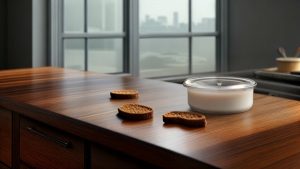Keeping your kitchen drawers organized is a key aspect of maintaining a clean and functional kitchen. Not only does it make it easier to find the right utensils and tools, but it also maximizes storage space and creates an aesthetically pleasing environment. However, organizing kitchen drawers can be a daunting task if you don’t know where to start. That’s why we’ve compiled this comprehensive guide to help you keep your kitchen drawers neat and tidy.
Key Takeaways:
- Organizing kitchen drawers is essential for a functional and visually appealing kitchen.
- Assessing your kitchen drawer needs and decluttering are crucial steps in effective kitchen drawer organization.
- Choosing the right organizers and storage solutions, arranging items in your kitchen drawers, and incorporating drawer liners are other key factors to consider.
- Maintenance, utilizing vertical space and drawer dividers, extending organization to other kitchen areas, and personalization are also important aspects of kitchen drawer organization.
Why is Kitchen Drawer Organization Important?
Have you ever found yourself rummaging through a messy kitchen drawer in search of a specific utensil or tool? Not only can this be frustrating, but it can also waste precious time and make cooking feel like a chore. That’s why kitchen drawer organization is crucial for maintaining an efficient and stress-free kitchen environment.
Decluttering kitchen drawers is the first step towards better organization. By sorting through items and deciding what to keep, donate, or discard, you can free up valuable space and ensure that only essential items are taking up drawer real estate.
Kitchen drawer organization tips can extend beyond simply decluttering. Well-organized kitchen drawers can help maximize storage capacity, allowing you to fit more items in a smaller space. By grouping similar items together and using appropriate dividers and organizers, you can also ensure that everything has a designated spot, making retrieval and organization much more efficient.
Furthermore, an organized kitchen can enhance the overall aesthetic of your home. Visitors to your kitchen will be impressed by the neatness of your drawers and the ease at which you can locate any utensil or tool.
By implementing some kitchen drawer organization tips and decluttering kitchen drawers, you can create a more functional and visually appealing space for all of your culinary needs.
Assessing Your Kitchen Drawer Needs
Before organizing your kitchen drawers, it’s essential to assess your needs to create an effective system that suits your lifestyle. By keeping your drawers organized, it becomes easier to access items, and you can maintain a clean and tidy space.
Start by analyzing the types of items you need to store in your drawers. Your utensils, cooking tools, and other appliances should be sorted into categories that make sense to you, such as baking tools, knives, and serving utensils.
Next, consider the available space you have in your drawers. This step will help determine the type and number of organizers you need. Keep in mind that you can maximize space by using adjustable drawer dividers, stacking organizers, or other smart kitchen storage solutions.
Finally, take into account your organizational preferences. Would you prefer that your most frequently used items be easily accessible, or do you prefer to group items by type? Understanding your preferences will help you create an effective system for maintaining organized kitchen drawers.
Sorting and Decluttering Your Kitchen Drawers
For effective kitchen drawer organization, it is crucial to start by decluttering and sorting your items. Here are some expert tips:
Step 1: Empty and Clean Your Drawers
Take everything out of your kitchen drawers and clean them thoroughly. This will help you see exactly what you have and ensure that you don’t put any unnecessary items back in.
Step 2: Sort Items into Categories
Sort your items into categories such as utensils, gadgets, baking tools, and so on. This will help you see what you have and make it easier to determine which items you need to keep, donate, or throw away.
Step 3: Assess Each Item
As you sort through your items, ask yourself when was the last time you used it, and whether you really need it. If it is still in good condition but you never use it, consider donating it or giving it to a friend who will get more use out of it.
Step 4: Decide What to Keep
After you have sorted and assessed each item, decide which ones you will keep. Only keep the items that you regularly use and that have a specific place in your kitchen.
Step 5: Organize Your Utensils
Organize your utensils by function, size or type. For example, group all of your spatulas together, all of your whisks together, and so on. This will make it easier to find the utensil you need quickly while cooking and baking.
Step 6: Use Drawer Organizers
Use drawer organizers to keep your utensils and other items separated and easy to access. Drawer dividers, bins, and trays can help you create specific spaces for each type of utensil or gadget.
By following these decluttering and organizing tips, you will be well on your way to creating a more functional and organized kitchen space.
Choosing the Right Organizers and Storage Solutions
Once you have sorted and decluttered your kitchen drawers, it’s time to think about the right storage solutions to keep them organized. With so many options available, it’s essential to choose the ones that work best for you and your kitchen needs.
Drawer Dividers
Drawer dividers are a popular choice for keeping utensils and tools separated and easy to find. Adjustable dividers allow you to customize the space based on the size of your items. You can choose from bamboo, plastic, or metal dividers, depending on your style and budget.
Drawer Inserts
Drawer inserts are another excellent option for organizing kitchen drawers. They come in various shapes and sizes and are perfect for grouping small items, such as spices, measuring cups, and utensils. You can also find inserts that fit specific kitchen drawer sizes, creating a tailored look and maximizing space usage.
Modular Systems
Modular systems allow you to create a customized storage solution for your kitchen drawers. These systems are typically made of durable plastic or metal and come with adjustable dividers and trays. You can mix and match various sizes and configurations to create a unique organization system that fits your kitchen’s needs.
Remember to consider your budget, the size of your kitchen drawers, and the types of items you want to store when choosing the right organizers and storage solutions. A combination of dividers, inserts, and modular systems can provide the perfect solution for organizing and storing your kitchen items.
Arranging Items in Your Kitchen Drawers
Once you have decluttered and sorted your kitchen drawer items, it’s time to think about how to arrange them effectively. A well-organized kitchen drawer not only makes it easier to find what you need but also maximizes the available space.
The first step in arranging items in your kitchen drawers is to group similar items together. For example, place all your cooking utensils in one compartment, and your baking tools in another. This will make it easier to find what you need and avoid clutter.
Pro Tip: Consider arranging items based on frequency of use. Keep the items you use most often within easy reach, and those you use less frequently towards the back of the drawer.
Another effective technique is to use drawer dividers, which help to keep items separated and prevent them from shifting around in the drawer. You can find adjustable dividers that fit most drawer sizes and can be moved as needed. By using dividers, you can create dedicated compartments for each type of utensil or tool.
For larger items such as pots and lids, consider using stacking organizers or vertical dividers to maximize storage space. This will help to keep items neat and prevent them from taking up too much room in the drawer.
Pro Tip: Don’t be afraid to experiment with different arrangements until you find what works best for you. You may find that you need to switch things up periodically as your needs change.
Remember, the key to effective kitchen drawer organization is to create a system that works for you. By grouping similar items, using dividers, and arranging items based on frequency of use, you can create a functional and easy-to-use kitchen space.
Labeling and Maintenance Tips
Maintaining organized kitchen drawers is a continuous process that requires regular cleaning and upkeep. To ensure your kitchen drawers remain tidy and functional, consider the following best practices:
- Label items: Labeling items in your kitchen drawers can help you quickly locate what you need and avoid confusion. Use labels that are easy to read and place them on the front of containers or drawers for easy visibility.
- Regular cleaning: Set a regular cleaning schedule for your kitchen drawers to avoid buildup of dirt and debris. Use a damp cloth or sponge to wipe down the insides of your drawers and organizers, and dry them thoroughly before replacing items.
- Periodic reevaluations: Regularly reassess your kitchen drawer needs to ensure that your current organization system is still working for you. Consider changing your organizers or storage solutions if they are no longer serving their purpose or if you need to accommodate different kitchen items.
By following these tips and incorporating them into your kitchen drawer organization routine, you can maintain a functional and neat kitchen space for years to come.
Incorporating Drawer Liners
If you’re looking for an easy way to extend the life of your kitchen drawers and protect your utensils, incorporating drawer liners is a smart choice. Drawer liners not only add a layer of protection against scratches and spills, but they can also help prevent items from slipping and sliding around inside your drawers, making it easier to find what you need quickly and efficiently.
When choosing a drawer liner, consider the material and thickness. Opt for liners made of materials that are easy to clean and won’t absorb moisture, such as vinyl or rubber. A thickness of at least 1/16 inch is recommended to provide adequate cushioning and protection for your utensils.
When installing the liner, measure the drawer carefully and cut the liner to fit snugly inside. Make sure to smooth out any wrinkles or bubbles for a neat and uniform appearance.
Effective kitchen drawer organization doesn’t stop at decluttering and arranging items. Incorporating drawer liners is a simple yet effective way to maintain the integrity and functionality of your kitchen drawers for years to come.
Utilizing Vertical Space and Drawer Dividers
When it comes to smart kitchen drawer storage solutions, utilizing the vertical space and drawer dividers can make a big difference. Adjustable dividers can help maximize space and keep utensils and tools organized and easy to find.
To organize utensils in kitchen drawers, consider sorting them by size or function and using adjustable dividers to create custom-sized sections for each type of utensil. This not only keeps utensils in their place and readily accessible but also prevents them from rubbing against each other, which can cause scratches and damage.
Stackable organizers can also be helpful in utilizing vertical space. These organizers allow for multiple levels of storage, which can help keep smaller items, like measuring spoons and cups, easily accessible while still making the most of limited drawer space.
When selecting drawer dividers and stackable organizers, be sure to choose ones that are sturdy and fit the size of your drawers. This will not only help ensure their effectiveness but also prevent them from shifting and causing disorganization.
Extending Organization to Other Kitchen Areas
While kitchen drawer organization is crucial for maintaining an efficient space, it’s also important to extend this mindset to other kitchen areas. By doing so, you can create a cohesive and functional kitchen environment.
Here are some kitchen drawer organization tips to help you extend organization to other areas:
Pantry:
Sort and arrange your pantry items in categories, such as snacks, canned goods, and baking supplies. Use clear containers to store items like cereal, flour, and sugar. Label each container to easily identify what’s inside. Keep frequently used items at eye level and within reach.
Cabinets:
Declutter your cabinets by getting rid of items you no longer use or need. Group similar items together, such as plates, bowls, and cups. Store heavy items on lower shelves and lighter items on upper shelves. Consider installing pull-out shelves for easier access.
Countertops:
Keep your countertops clutter-free by only displaying items you use on a regular basis, such as a coffee maker or fruit basket. Store small appliances like toasters and blenders in cabinets when not in use to free up counter space. Use a tray or decorative bowl to corral items like keys and mail.
By extending organization to other kitchen areas, you can create a more functional and visually appealing space. Use these kitchen drawer organization tips to get started and enjoy a well-organized and efficient kitchen.
Styling and Personalization Ideas
Once you’ve organized your kitchen drawers, you may want to take it a step further and add some personal flair to your storage solutions. Here are some creative ideas to consider:
- Use decorative containers: Consider using bins, baskets, or jars to store smaller items like spices or utensils. Not only do they add visual interest, but they can also help keep items grouped and easy to find.
- Try color-coding: Assign a color to each category of items, like red for cooking utensils and orange for baking supplies. Use colored drawer liners or labels to keep everything organized and easy to identify.
- Add labels: Labeling your drawers is a simple and effective way to keep everything in its place. Use a label maker or create your own labels with paper and adhesive.
- Install lighting: If you have deep or dark drawers, consider adding lighting for better visibility. LED lights can be easily installed and can make a big difference in finding what you need quickly.
Remember, the key to personalizing your kitchen drawers is to make sure it aligns with your style and organizational needs.
Conclusion
Keeping your kitchen drawers organized and tidy is essential for optimal functionality and aesthetic appeal. By utilizing smart kitchen drawer storage solutions, such as dividers, inserts, and liners, you can maximize storage space and keep utensils and tools neatly arranged.
Remember to assess your kitchen drawer needs, sort and declutter your items, and arrange them in a way that makes sense for your cooking style and preferences. Labeling and regular maintenance are also crucial for long-term organization.
Extend your organization efforts beyond the drawers to other areas of the kitchen, and consider adding personal touches to enhance both function and style. With these tips, you can achieve a functional and visually pleasing kitchen that makes cooking and entertaining a breeze.
FAQ
Q: Why is it important to keep kitchen drawers neat and tidy?
A: Keeping kitchen drawers neat and tidy is essential for easier access to utensils and tools, maximizing storage space, and creating a visually appealing kitchen.
Q: How can I assess my kitchen drawer needs?
A: To assess your kitchen drawer needs, consider the types of items you need to store, the available space, and your organizational preferences.
Q: What is the best way to declutter kitchen drawers?
A: Step-by-step instructions for decluttering kitchen drawers include sorting items into categories and deciding which ones to keep, donate, or discard. Additionally, tips on organizing utensils effectively are provided.
Q: What are some recommended organizers and storage solutions for kitchen drawers?
A: Various organizers and storage solutions, such as drawer dividers, inserts, and modular systems, are available in the market. Choose the ones that best suit your kitchen drawers.
Q: How should I arrange items in my kitchen drawers?
A: Arrange items in your kitchen drawers by considering frequency of use, accessibility, and grouping similar items together for easy organization and retrieval.
Q: Are there any labeling and maintenance tips for kitchen drawer organization?
A: Labeling items in kitchen drawers is important for easy identification. Regular cleaning and periodic reevaluations will help maintain long-term organization.
Q: What are the benefits of incorporating drawer liners in kitchen drawers?
A: Drawer liners protect utensils and prevent slipping. Choose appropriate liners for different types of kitchen drawers for optimal functionality.
Q: How can I utilize vertical space and drawer dividers in kitchen drawers?
A: Utilize vertical space by using adjustable drawer dividers or stacking organizers. This helps maximize storage capacity and keep items neatly arranged.
Q: How can I extend organization to other kitchen areas?
A: Extend organization beyond kitchen drawers to other areas, such as cabinets, pantry, and countertops, to create a cohesive and efficient kitchen space.
Q: Are there any styling and personalization ideas for organized kitchen drawers?
A: Enhance aesthetics and functionality by using decorative containers, labels, and color-coding systems in organized kitchen drawers.

It’s me, Amber Hayden, the heart and soul behind SagarmathaOnlineMedia.com. From a young age, I’ve been head over heels for everything home-related, from interior decor to gardening. I’m the type who can’t resist a well-crafted piece of furniture, and I firmly believe that a home isn’t complete without a pet or two. But it’s not just about creating pretty spaces for me. I’m all about making homes that tell a story reflecting the people living there. SagarmathaOnlineMedia.com is my way of sharing this passion with you. Whether you’re looking for tips to jazz up your living room, advice on pet care, or ideas to make your garden bloom, I’m here to help. So, let’s embark on this journey together and make your house a home!



